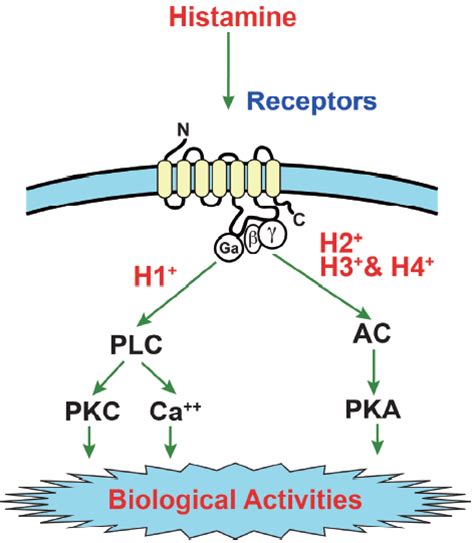Answer: Of the three histamine receptors in in the brain, H1 is generally excitatory, H2 is excitatory, and H3 is inhibitory.
Histamine is a naturally occuring neuromodulator compound. It is synthesized from the amino acid histidine by the enzyme L-histidine decarboxylase. Histamine is best recognized for its role in inflammation and itch, but it also serves a role in altering neurotransmission in the brain through release from neurons originating in the tuberomammillary nucleus.
All histamine receptors are G-protein coupled, seven transmembrane domain proteins that modulate cellular activity through activation and downstream signaling of G-proteins. While there are four histamine receptors, only three are epressed in the brain while the H4 receptor is expressed in immune cells.
Functions of histamine receptors
The H1 receptor is expressed in the brain. It is coupled with Gq proteins, which increases activity of phospholipase C (PLC), which increases intracellular stores of inositol 3 phosphate (IP3) and diacylglycerol (DAG), both of which increase cellular excitation. H1 receptors promote wake, so antagonists of the H1 receptor encourages sleepiness.
The H2 receptor is excitatory, and is coupled with Gs proteins. The Gs proteins act to increase cellular excitation by activation of adenylyl cyclase, which elevates intracellular levels of cyclic adenosine monophosphate (cAMP).
The H3 receptor is inhibitory. It is generally expressed on the presynaptic terminals of neurons. H3 is coupled with Gi/o proteins, which inhibit neuronal excitation through the decreased activity of cAMP in the cell terminal bouton. In addition to this main action of the alpha subunit, the beta / gamma complex can interact with and decrease calcium entry, which decreases vesicular release probability. They are usually autoreceptors at the histaminergic release terminals that serve to limit the amount of neurotransmitter that is released by the neurons.
Histamine receptors are known to contribute to a variety of drug addictions.
